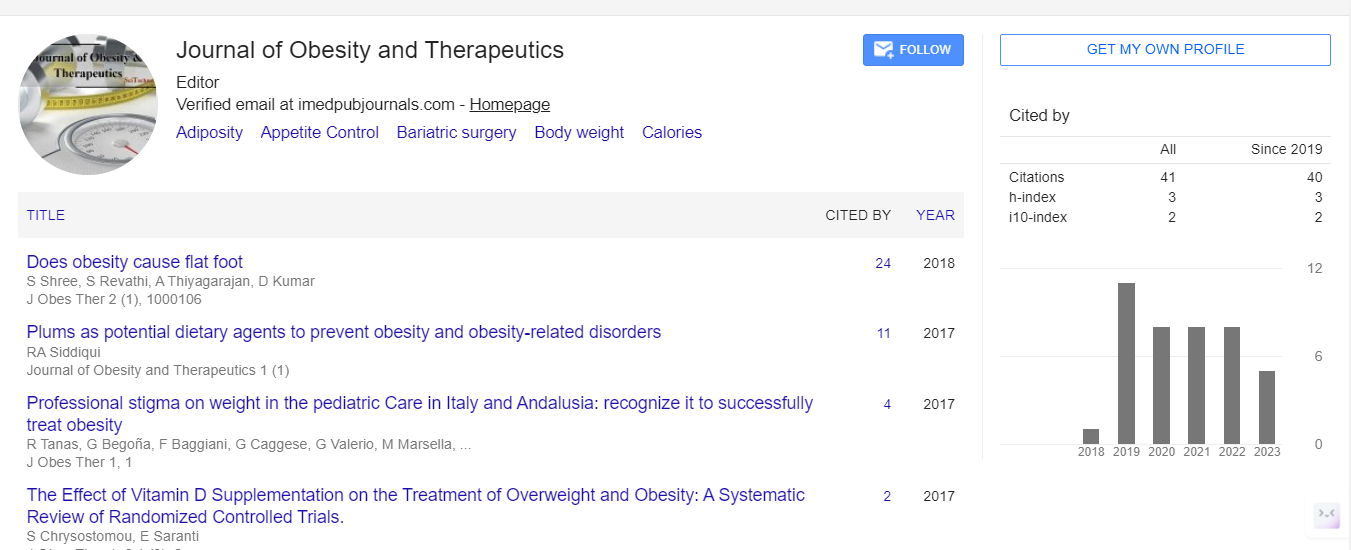Letter to Editor, J Obes Ther Vol: 5 Issue: 2
Obesity And Causes Of Childhood Obesity
Rafat A Siddiqui*
Nutrition and Food Science Laboratory, Virginia State University, USA
- *Corresponding Author:
- Rafat A Siddiqui
Nutrition and Food Science Laboratory, Virginia State University, USA
E-mail: rafatas6545@gmail.com
Received Date: September 14, 2021; Accepted Date: September 21, 2021; Published Date: September 28, 2021
Citation: Siddiqui RA (2021) Obesity and Causes of Childhood Obesity. J Obes Ther 5:2. 108.
Copyright: © All articles published in Journal of Obesity &Therapeutics are the property of SciTechnol, and is protected by copyright laws. “Copyright © 2021, SciTechnol, All Rights Reserved.
Keywords: Obesity, Activity, Child, Weight
Childhood Obesity
Obesity means having an excessive amount of body fat. It’s different from being overweight, which suggests weighing too much. Both terms mean that an individual’s weight is greater than what’s considered healthy for his or her stature. Children grow at particular rates, so it isn’t always simple to know when a child has weight or is overweight. Inquire your health care provider to check whether your child’s weight and height are amid a healthy range. If a weight-loss program is important, include the whole family in healthy habits so your child doesn’t feel singled out.
Encourage healthy eating by
• Serving more fruits and vegetables
• Buying less soft drinks and high-fat, high-calorie snack nourishments
• Making sure your child eats breakfast each day
• Eating fast food less often
• Not using food as a gift
Physical activity is also vital. Kids need about hour every day .It doesn’t have to be happen all at once. A few brief periods of activity during the day are indeed as good.
Causes
It is broadly acknowledged that increase in weight results from an imbalance between energy intake and expenditure, with a rise in positive energy adjust being closely related to the way of life adopted and so the dietary intake preferences. Be that as it may, there’s increasing evidence demonstrating that a person’s hereditary background is crucial in deciding obesity hazard.
Sugary beverages
Sugary drinks are less filling than food and may be consumed quicker, which ends up during a higher caloric intake. Sugary drinks are often thought of as being limited to soda, but juice and other sweetened beverages too drop beneath this category.
Snack foods
Another factor that has been studied as a possible contributing factor of childhood obesity is that the consumption of snack foods. Snack foods include foods like chips, food, and candy. Snacking has been shown to extend overall caloric intake leading to increase in weight.
Portion size
Portion sizes have increased drastically within the past decade. Consuming huge portions, furthermore to frequent snacking on exceedingly caloric nourishments, contribute to an excessive caloric intake. This energy imbalance can cause over weight, and subsequently obesity.
Activity level
One of the factors that are most importantly linked to obesity is a sedentary lifestyle. TV viewing among young children and adolescents has increased significantly in later years. The expanded sum of time spent in inactive behaviors has diminished the amount of time spent in physical activity.
Natural factors
While extensive TV viewing and the use of other electronic media has contributed to the inactive ways of life, other natural factors have diminished the opportunities for physical movement. Opportunities to be physically active and safe environments to be active in have decreased in the recent years.
Socio-cultural factors
Socio-cultural components have too been found to influence the advancement of obesity. Our society tends to use food as a gift, as a means to control others, and as a part of socializing. These uses of nourishment can empower the advancement of unhealthy relationships with food, subsequently expanding the hazard of developing obesity.
Family factors
Family factors have also been related to the rise of cases of obesity. The sorts of nourishment accessible in the house and thus the nourishment inclinations of family individuals can impact the foods that children eat. Additionally, family mealtimes can influence the sort of food consumed and therefore the amount thereof. Finally, family habits, whether they are inactive or physically dynamic, impact the child.
 Spanish
Spanish  Chinese
Chinese  Russian
Russian  German
German  French
French  Japanese
Japanese  Portuguese
Portuguese  Hindi
Hindi 